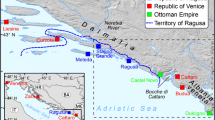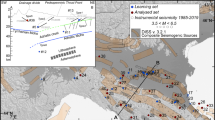Abstract
Iso-intensity contour maps were calculated on the basis of the intensity data derived from historical information about strongest earthquakes in Mexico. Intensity data contain a great deal of information that can be used to constrain the essential characteristics of the seismic source. In particular, both the seismological theory and its practice suggest that the orientation of the source of significant earthquakes is reflected in the elongation of the associated damage pattern. The present paper uses information about historical seismicity in Mexico from 1568 to 1837 to point out the sites, where the strongest damages took place. After information selection, maps of iso-intensities were built to determine epicentres. This information was interpreted, and damages and major risk zones were mapped. The systematic application of this method to all the M > 5.5 earthquakes that occurred in Mexico in the past five centuries produced encouraging results about the determination of the seismic source parameters that compare well with existing instrumental, geological, and geodynamic evidence.














Similar content being viewed by others
References
Aubouin J, Stephan JF, Roump J, Renard V (1982) The Middle America Trench as an example of a subduction zone. Tectonophysics 86:113–132
Bevis C, Isacks L (1984) Hypocentral trend surface analysis: probing the geometry of Benioff zones. J Geophys Res 89:6153–6170
Chiaruttini C, Siro L (1991) Focal mechanism of an earthquake of Baroque age in the “Regno delle Due Sicile” (southern Italy), in Investigation of historical Earthquakes in Europe. Stucchi M, Postpischl D, Slejko D (eds.), Tectonophysics 193:195–203
De Rubeis V, Gasparini C, Maramai A, Murru M, Tertulliani A (1992) The uncertainty and ambiguity of isoseisnal maps. Earthquake Eng Struct Dyn 21:509–523
Dewey JW, Suarez G (1991) Seismotectonics of middle America, the geology of North America decade map. Neotect North Am Seism Sect 1:309–321
Figueroa J (1970) Catalogo de sismos ocurridos en la Republica Mexicana. Revista del Instituto de Ingenieria 272:1–88
Figueroa J (1971) Sismicidad en la cuenca del Valle de Mexico. Revista del Instituto de Ingenieria 289:237–248
Figueroa J (1973) Sismicidad en Chiapas. Revista del Instituto de Ingenieria 316:1–51
Figueroa J (1974) Sismicidad en Puebla, Macrosismo del 28 de Agosto de 1973. Revista del Instituto de Ingenieria 343:1–68
Figueroa J (1975) Sismicidad en Colima. Revista del Instituto de Ingenieria 332:1–60
Figueroa J (1982) Sismicidad en Jalisco. Revista del Instituto de Ingenieria 459:1–33
Garcia-Acosta V, Suarez G (1999) Los sismos en la Historia de México. Fondo de Cultura Economica
Gasparini F, Bernardini F, Velensise G, Boschi E (1999) Defining seismogenic sources from historical earthquake felt reports. Bull Seism Soc Am 89:94–110
Jimenez Z, Ponce L (1978) Focal mechanism of six large earthquakes in northern Oaxaca, Mexico, for the period 1928–1973. Geofisica Int 17:379–386
Klitgord KD, Mammerickx J (1982) Northern East Pacific Rise; Magnetic anomaly and bathymetric framework. J Geophy Res 87:6725–6750
Lomnitz C (1974) Global tectonics and earthquake risk. Elsevier, Amsterdam
Malagon A (1989) Calibracion y estimacion de magnitudes para sismos historicos de Mexico. Bachelor thesis, Facultad de. Ingenieria, UNAM
Minster JB, Jordan TH (1979) Present-day plate motions. J Geophy Res 83:5331–5354
Molnar P, Sykes LR (1969) Tectonics of the Caribbean and Middle American from focal mechanisms and seismicity. Geol Soc Am Bull 80:1639–1684
Nishenko SP, Buland R (1987) A generic recurrence interval distribution for earthquake forecasting. Bull Seismol Soc Am 77:1382–1399
Nishenko SP, Singh SK (1987) Conditional probabilities for the recurrence of large and great interplate earthquakes along the Mexican subduction zone. Bull Seismol Soc Am 77:2095–2114
Nuñez-Cornu F, Ponce L (1989) Zonas Sismicas de Oaxaca, Mexico: Sismos Maximos y Tiempos de Recurrencia para el periodo 1542–1988. Geofisica Intrnacional 28–4:587–641
Ohta Y, Satoh K (1980) Analysis on seismic intensity and earthquake disaster in the Caldiran earthquake. In: Ohta Y (ed) Engineering seismological studies on the 24 November 1976 Caldiran earthquake in Turkey. Dept Arch Eng Hokkaido Univ, Sapporo, pp 89–117
Orozco y Berra J (1887–1888) Seismologia. Efemerides sismicas mexicanas. Memorias Sociedad Cientifica “Antonio Alzate”. Mexico 1:303–537
Protherro WA, Reid ID (1982) Microearthquakes on the East Pacific rise at 21° N and the Rivera fracture zone. J Geophy Res 87:8509–8518
Reiter L (1991) Earthquake hazard analysis. Columbia U. Press, New York
Shebalin NV (1973) Macroseismic data as information on source parameters of large earthquakes. Phys Earth Planet Interior 6:316–323
Singh SK, Astiz L, Havskov J (1981) Seismic gaps and recurrence periods of large earthquakes along the Mexican subduction zone; A reexamination. Bull Seism Soc Am 71:827–843
Singh SK, Rodriguez M, Espindola JM (1984) A catalogue of shallow earthquakes of Mexico from 1900–1981. Bull Seism Soc Am 74:267–279
Sirovich L (1996) A simple algorithm for tracing synthetic isoseismals. Bull Seism Soc Am 86:1019–1027
Stewart GS, Chael EP, McNally KC (1981) The 1978 November 29, Oaxaca, Mexico, earthquake; a large simple event. J Geophy Res 86:5053–5060
Suarez G, Garcia-Acosta V, Gaulon R (1994) Active crustal deformation in the Jalisco block for a great historical earthquake in the 16th century. Tectonophysics 234:117–127
Wells Dl, Coppersmith KJ (1994) New empirical relationships among magnitude, rupture length, rupture with, rupture area, and surface displacement. Bull Seism Soc Am 84:974–1002
Acknowledgments
This work was supported by the Consejo Nacional de Ciencia y Tecnologia (CONACyT) project number: I37890-T.
Author information
Authors and Affiliations
Corresponding author
Rights and permissions
About this article
Cite this article
Torres-Vera, MA. Historical seismicity in Mexico during 1568–1837: intensity evaluation and data reliability. Nat Hazards 54, 863–878 (2010). https://doi.org/10.1007/s11069-010-9510-0
Received:
Accepted:
Published:
Issue Date:
DOI: https://doi.org/10.1007/s11069-010-9510-0




